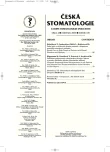Repeated Endodontic Treatment
Authors:
Ľ. Harvan; J. Stejskalová
Authors‘ workplace:
Klinika zubního lékařství LF UP a FN, Olomouc
Published in:
Česká stomatologie / Praktické zubní lékařství, ročník 109, 2009, 4, s. 54-58
Category:
Overview
The aim of this work was to sum possible reasons of primary endodontic therapy, to judge causes of frequent endodontic treatment and evaluate its success. The collection consisted of 41 teeth from patients, who were recommended to our clinic to perform the reendodontic therapy in 2007. Final findings were compared to similar study, which was performed on the same workplace in 1997. This comparison formed the result – the main reason of repeated treatment is incomplete filling of root canals and impossibility to find one of the root canals.
Key words:
primary canal therapy - repeated canal therapy - access rate of therapy
Sources
1. Dirheimer, M.: Strojové opracování kořenového kanálku systémem RaCe. Quintessenz, 16, 2007, s. 7-13.
2. Christopher, P.: pH Required to Kill Enterococcus faecalis in Vitro. JOE, 30, 2004, s. 218-219.
3. Siqueria, J. F.: Effects of chemomechanical preparation with 2,5% Sodium Hypochlorite and intracanal medication with calcium hydroxide on cultivable bacteria in infected root canals. JOE, 33, 2007, s. 800-805.
4. Souza, R. A.: The importance of apical patency and cleaning of the apoical foramne on root canal preparation. BDJ,. 17, 2006, s. 6-9.
5. Stejskalová, J., Macháčková, L.: Opakované endodontické ošetření. Praktické zubní lékařství, 46, 1998, s. 174-180.
Labels
Maxillofacial surgery Orthodontics Dental medicineArticle was published in
Czech Dental Journal

2009 Issue 4
- What Effect Can Be Expected from Limosilactobacillus reuteri in Mucositis and Peri-Implantitis?
- The Importance of Limosilactobacillus reuteri in Administration to Diabetics with Gingivitis
Most read in this issue
- Repeated Endodontic Treatment
- Dental Care in Risk Groups of Patients with Mental Disorders and Epilepsy
- Computer Supported Dental Reconstruction in the Patients with Abrasion and Temporomandibular Joint Disorders (A Case Report)
- Nanomaterials in Dentistry – State of The Art
